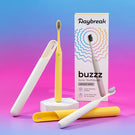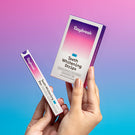Are you looking for a safe and effective way to brighten your smile? With so many over-the-counter (OTC) teeth-whitening products on the market, it can be challenging to find the right one for you. A recent study compared the whitening effect, safety, and enamel surface alterations induced by different OTC whitening agents. The results may surprise you!
Introduction
Teeth-whitening has become increasingly popular among those who suffer from stained or yellow teeth due to lifestyle, genetic or ageing related factors. OTC whitening systems based on hydrogen peroxide or carbamide peroxide are widely used in western markets including the US. While these can be effective, studies have reported enamel surface changes and increased sensitivity after peroxide-based treatments.
Due to regulations, OTC products in the European Union often contain alternative active ingredients, such as phthalimidoperoxycaproic acid (PAP), sodium chlorite, or sodium bicarbonate. Natural compounds like enzymes, including bromelain from pineapple stems, have also been tested as whitening agents. In India too, peroxide-based formulations are strictly regulated by government authorities.
The Study
In this study, human teeth were divided into six groups and stained with coffee for 7 days. After staining, they were treated with different whitening agents for 7 more days. The whitening agents tested were hydrogen peroxide, bromelain, sodium bicarbonate, sodium chlorite, and PAP. Color measurements and scanning electron micrographs were used to assess the whitening effect and enamel surface alterations. Cytotoxicity (i.e. toxicity to cells) was evaluated using primary human fibroblasts.
Results
While hydrogen peroxide proved to be the most effective whitening agent, it also caused enamel surface dissolution. This implies that sustained use of peroxide-based whitening products is likely to result in deteriorating enamel health and symptoms such as sensitivity. Other studies have shown hydrogen peroxide to carry significant risk of gingival (gum) irritation when used at home.
Sodium bicarbonate showed an intriguing whitening effect, and images revealed it adhered (stuck) to the enamel surface. However, the study concludes "that the exact whitening mechanisms of sodium bicarbonate, apart from its abrasive effect, remain unknown". The abrasive properties of sodium bicarbonate and other whitening ingredients like activated charcoal are likely to result in enamel damage over the long run.
PAP and bromelain were the two ingredients included in the study which effectively removed stains without causing surface alterations. These ingredients, therefore, represent the gold standard in safe yet effective at-home whitening treatments.
Daybreak's teeth whitening range which comprises of our revolutionary Teeth Whitening Strips and Teeth Whitening Pen contain PAP as well as hydroxyapatite to remineralize the enamel while simultaneously eliminating persistent stains. Daybreak's toothpaste contains bromelain and papain - enzymes derived from pineapples and papayas that are known to brighten your teeth without abrasion. Shop now!







